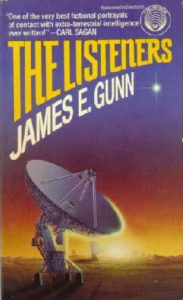 A decade before Carl Sagan’s blockbuster novel, Contact, James Gunn had a first contact novel with essentially the same elements. A SETI research lab in perpetual threat of funding cuts finally receives a clear signal from the stars.
A decade before Carl Sagan’s blockbuster novel, Contact, James Gunn had a first contact novel with essentially the same elements. A SETI research lab in perpetual threat of funding cuts finally receives a clear signal from the stars.
The scientists scurry to interpret it and arrive at a pictorial representation (as in Sagan’s novel). Debate follows: is it safe to send a reply? They do. Ninety years later, the characters, grandsons of the original characters (males only, please) receive the answer to the reply, which is thought-provoking.
The novel was originally a set of short stories and that shows. Disconnected scenes are crudely stitched together with dozens and dozens of quotations from SETI scientists of the ’50s and -60s (including Sagan) dumped in without connecting tissue.
The novel is not well-written or well-structured, and it has few ideas. Characters are tedious and unengaging. But in the mid-century context, this was one of the earliest first contact stories of the modern era (using radio telescopes) and as that, it is an interesting historical document.
It also has a strong psi-fi component. Any thoughtful first contact story is going to be psi-fi, because that’s what first contact is all about. The science is relatively authentic for its day, but the psychology of the humans is the main point of the story, as it was for Stanislaw Lem’s His Master’s Voice, which came out only a few years before this one.
Can humans ever hope to put their anthropocentric assumptions aside to interpret “objectively” an alien message. I am not as sanguine as Gunn or Sagan. And then, if there is to be a reply to the aliens, what should it say and who should say it? These are hard psi-fi questions and I am happy to see them addressed in the literature, even if badly.
Gunn, James E. (1972) The Listeners. New York: Del Ray Books, 226 pp.